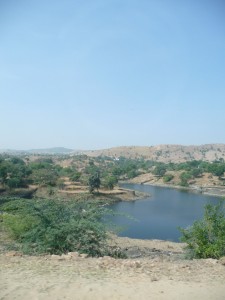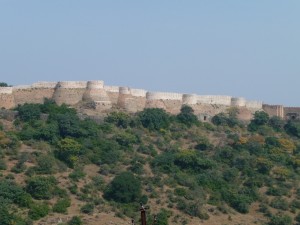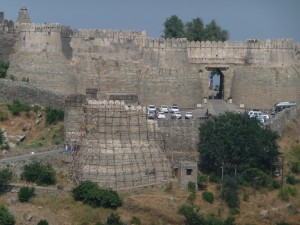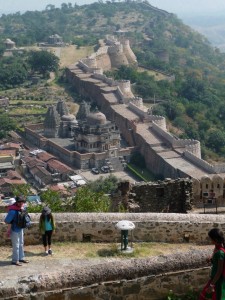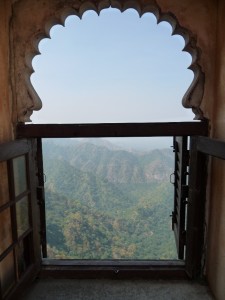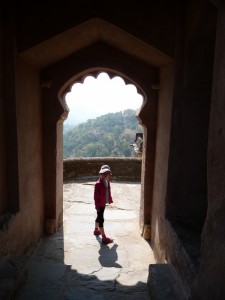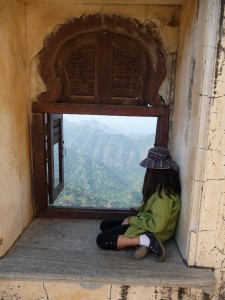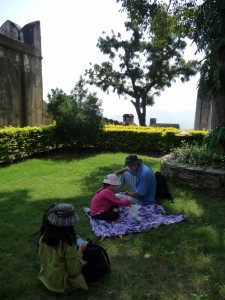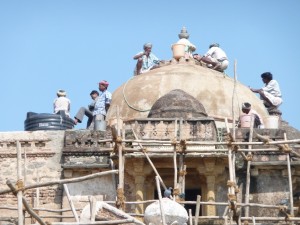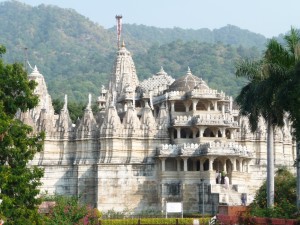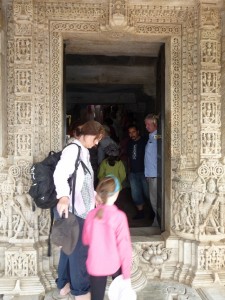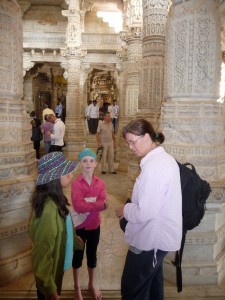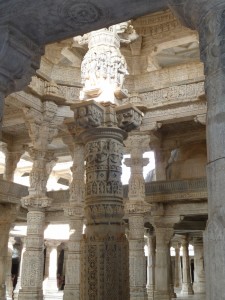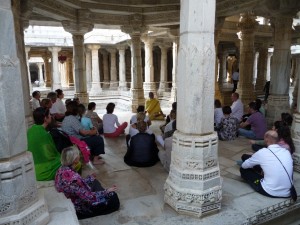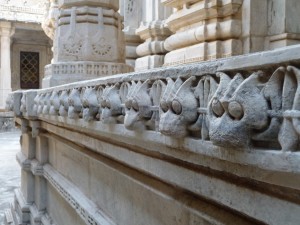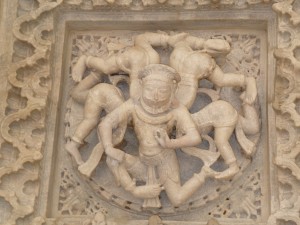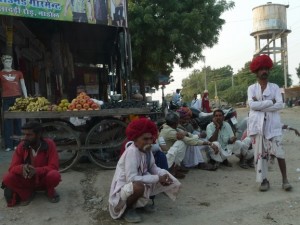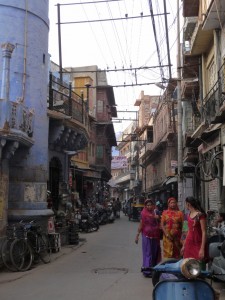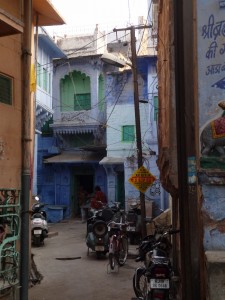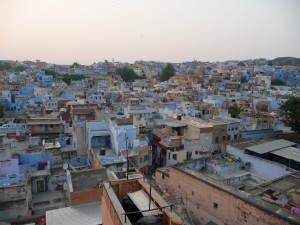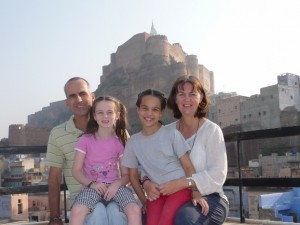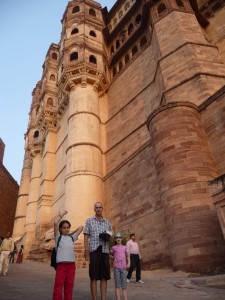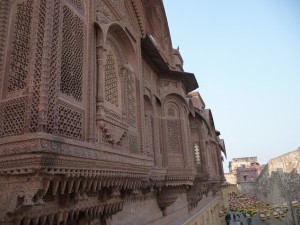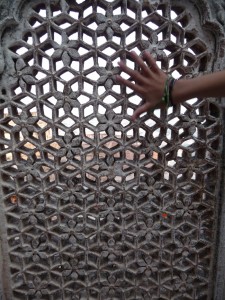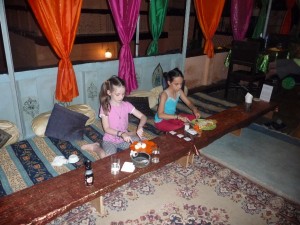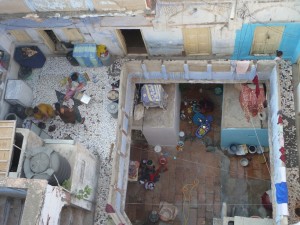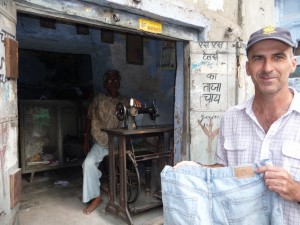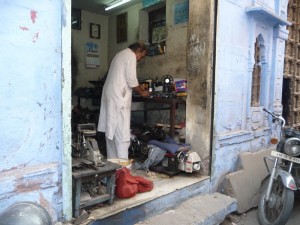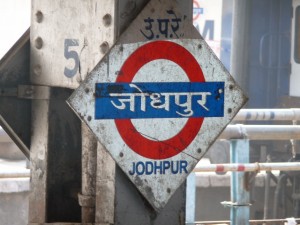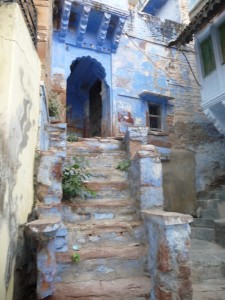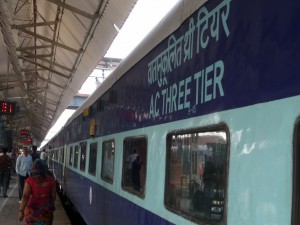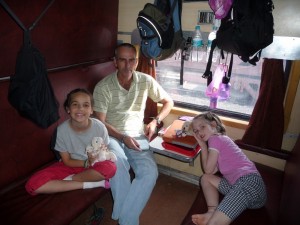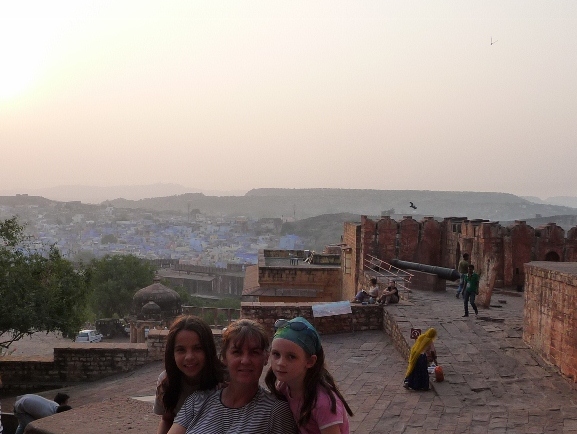The Jodhpur blues…
Posted by asuasu69 on Nov 7, 2012 in India | 0 commentsWhen we arrived in Udaipur we had looked into organising our onward journey to Jodhpur by train, when it became apparent that two historical landmarks were actually just under half way to Jodhpur so it made sense to do this sector using a private car and driver. The cost of the road trip was also comparative to four train tickets (in 2nd class A/C) at 2800Rupees/$51.
Jodhpur is just under 300km to the north but when you ask someone in India ‘How far is it from A to B?’ the answer is almost always given in time, not kilometres. We departed Udaipur at 9am and finally reached our accommodation in Jodhpur at 7pm, which equated to roughly six and a half hours driving and three and a half hours of exploring at our two stops. A long day for everyone especially little Imms who was on her third day of a bout of gastro and who spent the entire time in the car with her head on my lap. Despite this, taking a private car was definitely a wise decision as it allowed us the flexibility to see two very significant attractions in southern Rajasthan that we would have missed if we had come by train.
Kumbhalgarh was our first stop. A remote fort built 1433-68 and at an elevation of 1100m is surrounded by an impressive 36km long wall. The fortified wall is so thick in places that it is wide enough for eight horses to stand abreast. The Indians also claim this defensive wall length is second only to the Great Wall in China.
The fort was only taken by enemy forces once in its entire history with the combined effort of three armies, and even then they were only able to hold it for two days. The fort encompasses such a large area that it included 400 smaller temples and 700 ammunition caches. Also within the fort another smaller defensive wall surrounds a palace complex. Although the palace is now completely empty, we took the time to wander through the various rooms; walls coated in the usual white plaster to give the marble effect, and frescos depicting elephants wrestling crocodiles. We even had access to the roof of the palace which is the highest point in the area for some spectacular views.
Our second stop was at Ranakpur; a Jain temple built in the 15th century entirely from gleaming milk-white marble and an absolute masterpiece. This is possibly the most beautiful and ornate temple we have ever seen. While it is not as large as some of the temples in Asia, it does have a complicated array of halls, domes and 1444 uniquely carved marble columns. Animal products (eg. Leather handbags or belts), water and food are not permitted inside the temple due to the Jain religious beliefs, however entry was free and only a small fee applied for the use of a camera.
Despite the hordes of visitors, the temple did have a very calming atmosphere and I was quietly sitting and taking in the amazing craftsmanship when interrupted by the Temple ‘Guru’ instructing a group of French tourists to sit cross-legged on the marble floor, hands resting on the knees, fingers in the meditation position and eyes closed, while he chanted some ‘ohms’ and then moved around the group repeatedly asking for donations, to which they obediently complied. Thinking I was part of the French tour group he asked repeatedly for my donation until I advised him ever so politely that I was enjoying my own silent meditation until he interrupted me!
The road trip continued and was an adventure in itself; the roads were so shocking in parts it was literally unbelievable that it was a major road, but the glimpses of life as we cruised on by will be forever etched in my memory – the red turbaned men sitting around, the children playing by the roadside in squalor, the trucks and carts piled high with goods/hay/produce, the endless rubbish by the roadside near villages, the kids waving and calling out as we passed, men urinating anywhere and everywhere – it was everything I thought it would be and more.
The poorly maintained roads, grazing cattle, goats and stray children to contend with along the way all contributed to the long journey with the last hour or so being the most nail-biting. It seems along with refusing to put the air-conditioner on due to perceived additional running costs they also don’t turn the headlights on either once the sun goes down!?! Dodging trucks, cars, carts and livestock becomes a little more nerve wracking in the dark! So while the car trip made sense it was one experience I wasn’t in a hurry to repeat but wouldn’t want to have missed.
The car and driver was arranged by the hotel owner in Udaipur, and the driver explained that after dropping us at Jodhpur that night, he would return immediately to Udaipur with the car. I estimate his entire return trip would be not less than 15 hours, and he told me his pay for the day would be R300 or about $6…the rest is kept by the guesthouse to cover fuel, running expenses and profit. We were dropped us just outside the city walls and got an autorickshaw to navigate us through the busy and congested narrow laneways of the old city to our guesthouse.
Jodhpur is situated on the eastern fringe of the Thar Desert and is known as ‘The Blue City’ due to the colour painted on the exterior of a lot of the houses in the old city. Once, blue was the colour used only by nobility, or Brahmin Caste but these days everyone has got in on the act and from a distance the city takes on the appearance of a jumble of blue lego blocks.
Our accommodation was in the midst of the old city; a twisting, turning maze of roads with narrow lanes leading off at all angles, and all quite flat, unlike Udaipur.
The saving grace for Jodhpur as far as we were concerned was the Mehrangarh or Jodhpur Fort, which literally overlooked our guesthouse.
Construction began in 1459 and has been enhanced over the years to become an impressive fortress protecting a beautifully carved stone palace. The stone block battlements surrounding the fort range in height from 6 to 36 metres. The damage in the stonework from cannon artillery is still visible around one of the 7 gates into the fort and the original massive timber doors from the main gate are proudly on display showing some neat 6 inch cannon ball holes.
The exterior of the palace is beautifully carved pink sandstone which looks like carved timber from a distance. The inside of the palace has now been transformed into a museum and contains impressive displays of howdahs (elephant chairs), baby cots, palanquins and weapons (of course!).
We stayed in a guesthouse called a Haveli (a building of historical and architectural significance) in the shadow of the fort for four days and didn’t venture out much as Immi, still recovering from gastro really lacked energy. The closed front gate on the Haveli also gave shelter from the sheer ‘in your face’ craziness, noise, stinking rubbish and excrement everywhere. This was by far the dirtiest city we had been in and also the least enjoyable accommodation (sheets had holes and were worn through, pillows were just ewwhh!). There appeared to be only men and boys working at this guesthouse and the general cleanliness was questionable, however the effort required in moving somewhere else was too tiring to contemplate. It did have an attractive eating area where the girls enjoyed sitting down on the cushions. We were not feeling the most adventurous with our food options at this present time and I think omlette featured at least once daily for each of us.
If truth be known we were now counting down to our departure. That classic love-hate relationship synonymous with India was rearing its head; I think we are getting tired of the constant noise, pollution and chaos plus the constant feeling of dirt and grime that permeate our skin, but conversely never fail to be surprised by the often bizarre, colourful and amazing sights that greet us each time we go out and about exploring.
The old city is a myriad of tiny hole-in-the-wall type stalls where men sit bare foot and cross-legged selling everything from padlocks and kitchenware to books. Also several vintage sewing machine stalls like the one David had the seat of his jeans repaired for fee of 20 rupees(.35cents!) . David gave him the huge tip of 50 rupees (just under $1)
Right from the start, booking train tickets at short notice for the train journey Jodhpur to Jaipur was looking shaky. The Indian Railways are the world’s largest employer and on any given day more than 18 million people are travelling by rail somewhere in India so trains are fully booked weeks in advance. Mind boggling! I had spent hours researching the train system, information regarding the tourist quota and tatkal quota (a limited amount of emergency seats released 24hours before at an additional fee). You can buy tickets on-line, however the recently changed security means you must register before being able to view availability and provide copies of passports before booking the seats.
The renowned Dewali or Deepavali Festival was due to begin the day after our scheduled departure and the city was becoming very busy. Forty-eight hours before our hoped departure, Dave headed to the train ticket booking office as we were unable to make any progress with booking tickets on Clear Trip (the online booking site). He managed to purchase four a/c second class chair tickets although we were waitlisted in the queue at numbers 16-19. At first we thought this was promising as some trains have in excess of 400 passenger’s waitlisted. After closely watching our status and seeing no improvement in our position on the waitlist after twenty-four hours, I made the decision to return to the ticket office and try for some confirmed tickets in a lesser class (using the tatkal emergency released quota seats).
Buying seats is easier said than done, each time you purchase train tickets you have to queue for forms to complete, then queue again for either information and if you are lucky find a dedicated window for foreign tourists. However they do not offer information, i.e. on the form you must state what class you want and if it is not available they do not suggest another class that does have availability, you have ask for each class availability one by one and change the form accordingly – and there are at least eight classes of seating from First Class air-conditioned right down to 3rd class sleeper non air-conditioned. To be in the running for the emergency quota tickets you must front up to the railway station within twenty-four hours of expected departure as these are not available on-line. Sometimes it worked to our benefit to not have planned ahead; our trip from Udaipur to Jodhpur for example, but generally speaking travel by train was the most comfortable and our preferable way to travel.
So finally we could rest easy knowing that the next day would be our last trek back to the Jodhpur train station this time bound for Jaipur.
The three tier air conditioned class (3A) sleeper cabin (three tiers of bunks that fold up so three people sit on the bottom bunk during the daytime journey) was relatively clean and suited us perfectly, and was actually more comfortable than the chair class which is more like a bus style seating. We were able to enjoy some games of Uno, both girls did some schoolwork and Immi had an hour of sleep.
Two hours into our journey we saw miles of salt lakes stretching on either side of the train and shimmering out of the desolate plains as a mirage. Although this area of India is predominately flat, occasionally a higher feature would rise out of the plain with a small fort perched on top. We also passed through an area of marble quarries with rows of cranes leaning over large pits and industrial estates by the side of the train tracks where gantry cranes carry large rectangular blocks of marble to the saws for slicing and transforming into the beautiful white sheets used in so many buildings.
Feeling in need of a step up in accommodation standard we had booked a stay at a Heritage Hotel on a two acre estate not far from the centre of Jaipur, run by a retired Indian Navy Admiral. With a garden and a pool we were looking forward to a bit of space and time out and check out a few sights that Jaipur had to offer.

